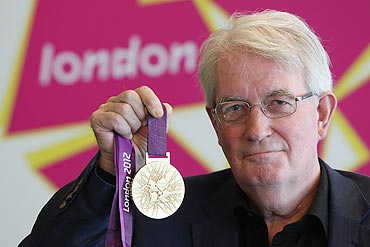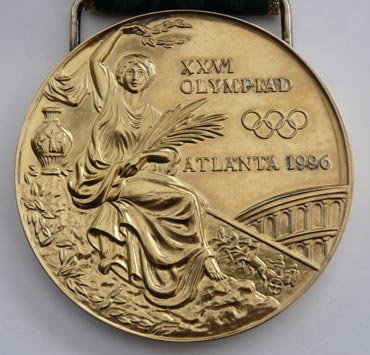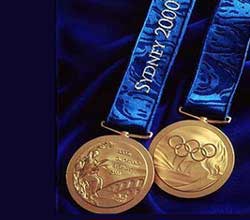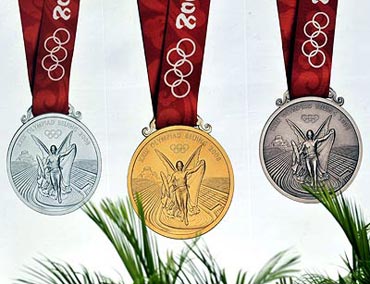With less than a year to go for the London Olympics, the medals for the Games were revealed in Trafalgar Square on Wednesday. Rediff.com presents an insight into the designing of the medals.
Since 1928 Olympic medals have featured the same design on the front -- a Greek goddess, the Olympic rings, the coliseum of ancient Athens, a Greek vase known as an amphora, a horse-drawn chariot, and the year, number of the Olympiad, and host city.
The host city is allowed to add special details to this design.
From 1928 to 1968, the medals for the Summer Olympics were identical. It was only in 1972 that the Organising Committee of the Munich Games decided to have a different design on the reverse of the medals.
No medals awarded till 1904 Games in St Louis
Image: The 2012 London Olympics medalsAnother interesting point to note is that in the ancient Olympics, no medals were awarded to the winners. The athlete who finished first was given an olive wreath to wear on his head while the second and third place finishers got nothing.
With the revival of the modern Olympics in 1896, the winners received a silver medal, while those who finished second received one of bronze. The third finisher had to leave empty-handed.
However, since the 1904 Games, in St Louis, the sequence of gold-silver-bronze medals for the first three places started.
Click Next to read details of the designs of the last four Games.
1996 Atlanta Olympics
Image: 1996 Athens Olympics medalWork on the design of the 1996 Atlanta Olympics began in 1994. However, later design was refined when the designer of the 1996 pictograms was awarded a contract to work on the victory and commemorative medals.
The medals were designed by Giuseppe Cassioli and Malcom Grear.
This was the first time that the medals had sport-specific designs, as each was engraved with the name of the event.
The obverse of the medals had the design that depicts the goddess of victory, Nike, holding a bundle of palm leaves in her left arm. Her right hand holds a wreath of olive leaves above her head. Behind her stands the ancient Coliseum with a horse-drawn chariot. An amphora is also included in the design.
The reverse of the medal displays the 1996 Games logo and the sport pictograms signifying the event won by the athlete.2000 Sydney Olympics
Image: The Sydney Olympics medalsThe medals designed for the Sydney Olympics had the traditional Olympic emblems with famous landmarks of Sydney.
Designed by Australian sculptors Wojciech Pietranik and Brien Thompson, the medals have the Opera House featuring on the reverse side of the medals along with a depiction of the Sydney 2000 Olympic torch. Both Australian icons are linked by fluid waves representing the water of Sydney Harbour and the ocean.
The final icon on the reverse is the five Olympic rings, overlaid in the centre of the design.
On the front is Nike, the Goddess of Victory, holding a laurel wreath over her head, while cradling a bundle of palm fronds in her arms, seated next to a grecian urn. Below Nike are sprigs of wattle, the Australian national flower.
The medals were made by The Royal Australian Mint in Canberra and the Perth Mint.
This was the first time that medals had a personalized touch, as winning athletes were able to have their name engraved on the obverse side, where space had been allowed for that purpose.
2004 Athens Olympics
Image: The reverse of the Athens Olympics medalA new design was created for the 2004 Athens Games, which features the Greek Panathenaic Stadium (where the modern Olympics were revived in 1896) and a new image of Nike.
The new image was based on a statue carved in 421 BC which was kept in the Temple of Zeus in Olympia, and shows Nike flying into the stadium as if to crown the winners with a wreath.
The medal was designed by Elena Votsi.
On the reverse of the medal, three elements are depicted. The eternal flame that is lit in Olympia for every Olympic Games, the opening lines of Pindar's Olympic Ode composed in 460 BC to honour an Olympic wrestling winner, and the Athens Games emblem.
The IOC approved the new design and decided to adopt it for the Games to come.
2008 Beijing Olympics
Image: The Beijing Olympics medalsThe medals for the Beijing Games were the first for an Olympics to be designed by winners of a public competition.
Each has a distinctive inlay of jade, which represents beauty, nobility, perfection, power and immortality to the Chinese.
The metal -- 13.04 kg of gold, 1,340 kg of silver and 830 kg of copper -- came from the mines in Australia and Chile, while the jade was sourced in China.







Comment
article